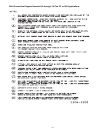
45
Installation (Continued)
Field Installed Control Wiring
The Rooftop Module (RTM) must have a mode input in or-
der to operate the rooftop unit. The flexibility of having sev-
eral system modes depends upon the type of sensor and/or
remote panel selected to interface with the RTM. An overall
layout of the various control options available for a Constant
Volume application, with the required number of conductors
for each device, is illustrated in Figure 3-16. Figure 3-17 il-
lustrates the various control options with the required num-
ber of conductors for a Variable Air Volume application.
Note: All field wiring must conform to NEC
guidelines as well as state and local codes.
The various field installed control panels, sensors, switches,
and contacts discussed in this section require both AC and
DC consideration. These diagrams are representative of
standard applications and are provided for general refer-
ence only. Always refer to the wiring diagram that shipped
with the unit for specific electrical schematic and connection
information.
WARNING
Hazardous Voltage!
Disconnect all electric power, including remote discon-
nects before servicing. Follow proper lockout/tagout
procedures to ensure the power can not be inadvert-
ently energized. Failure to disconnect power before ser-
vicing could result in death or serious injury.
Controls using 24 VAC
Before installing any connecting wiring, refer to Figure 3-2
for the electrical access locations provided on the unit and
Table 3-8 for AC conductor sizing guidelines, and;
a. Use copper conductors unless otherwise specified.
b. Ensure that the AC control wiring between the
controls and the unit's termination point does not
exceed three (3) ohms/conductor for the length of
the run.
Note: Resistance in excess of 3 ohms per
conductor may cause component failure due to
insufficient AC voltage supply.
c. Be sure to check all loads and conductors for
grounds, shorts, and miswiring.
Table 3-8
AC Conductors
Distance from Unit Recommended
to Control Wire Size
000 - 460 feet 18 gauge
461 - 732 feet 16 gauge
733 - 1000 feet 14 gauge
d. Do not run the AC low voltage wiring in the same
conduit with the high voltage power wiring.
Controls using DC Analog Input/Outputs
Before installing any connecting wiring between the unit and
components utilizing a DC analog input\output signal, refer
to the appropriate illustration in Figure 3-2 for the electrical
access locations provided on the unit and
Table 3-9 for conductor sizing guidelines and;
a. Use standard copper conductor thermostat wire
unless otherwise specified.
b. Ensure that the wiring between the controls and the
unit's termination point does not exceed two and a
half (2.5) ohms/conductor for the length of the run.
Note: Resistance in excess of 2.5 ohms per
conductor can cause deviations in the accuracy of
the controls.
Table 3-9
DC Conductors
Distance from Unit Recommended
to Control Wire Size
000 - 150 feet 22 gauge
151 - 240 feet 20 gauge
241 - 385 feet 18 gauge
386 - 610 feet 16 gauge
611 - 970 feet 14 gauge
c. Do not run the electrical wires transporting DC
signals in or around conduit housing high voltage
wires.
Units equipped with a Trane Communication Interface (TCI)
or LonTalk Communication Interface (LCI) option which uti-
lizes a serial communication link;
a. Must be 18 AWG shielded twisted pair cable (Belden
8760 or equivalent).
b. Must not exceed 5,000 feet maximum for each link.
c. Must not pass between buildings.
Constant Volume System Controls
Remote Panel w/o NSB (5U56) - BAYSENS010B
This electronic sensor features four system switch settings
(Heat, Cool, Auto, and Off) and two fan settings (On and
Auto) with four system status LED's. It is a manual or auto-
matic changeover control with dual setpoint capability. It can
be used with a remote zone sensor BAYSENS017B. Refer
to Table 3-10 for the Temperature vs Resistance coefficient.
Remote Panel w/ NSB (5U58) - BAYSENS019*
This 7 day programmable sensor features four periods for
Occupied\Unoccupied programming per day. If the power is
interrupted, the program is retained in permanent memory.
If power is off longer than 2 hours, only the clock and day
may have to be reset.
The six programming keys located on the front panel allows
selection of four system modes (Heat, Cool, Auto, and Off),
two fan modes (On and Auto). It has dual temperature se-
lection with programmable start time capability.


















